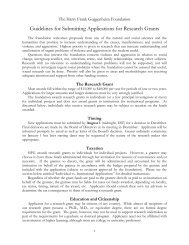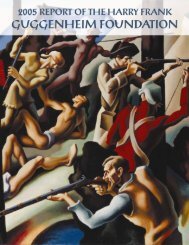Small Arms and Light Weapons - Harry Frank Guggenheim ...
Small Arms and Light Weapons - Harry Frank Guggenheim ...
Small Arms and Light Weapons - Harry Frank Guggenheim ...
- No tags were found...
You also want an ePaper? Increase the reach of your titles
YUMPU automatically turns print PDFs into web optimized ePapers that Google loves.
international humanitarian law. Does the presenceof SALW exacerbate or lengthen armed conflict?dem<strong>and</strong> for small armsAnalyzing dem<strong>and</strong> for small arms involvesexamining who possesses <strong>and</strong> carries them, whattypes are acquired, <strong>and</strong> the motivations for acquiringthem. Knowledge of dem<strong>and</strong> is important inthe design of programs intended to address thenegative effects of these weapons, e.g., demobilization,disarmament, <strong>and</strong> reintegration (DDR) of excombatants,as well as programs for collection <strong>and</strong>destruction of weapons.international efforts at controlThe 2001 UN Programme of Action on <strong>Small</strong><strong>Arms</strong>, <strong>and</strong> various regional treaties <strong>and</strong> frameworks,have been developed to address the globalproblems associated with small arms <strong>and</strong> lightweapons. Evaluation research has been conductedto assist in monitoring <strong>and</strong> evaluating these collaborativeefforts. Such treaties <strong>and</strong> protocols shouldbe compiled into a database to avoid duplication<strong>and</strong> promote complementarities <strong>and</strong> synergies.design <strong>and</strong> evaluation of practical policies<strong>and</strong> programsA significant amount of research has been conductedon the programs designed to alleviate thenegative effects of small arms. Much of it is classicprogram evaluation, with a focus on evaluatingneeds assessment, goals <strong>and</strong> objectives of the program,program design, implementation, <strong>and</strong> impact.Compilation of “lessons learned” <strong>and</strong> “bestpractices” is the typical outcome of this research.Most of this work has focused on the followingtypes of programs:• Disarmament, demobilization, <strong>and</strong> reintegration(DDR) of ex-combatants• Amnesties <strong>and</strong> weapons collection• Destruction of surplus weapons• Increasing public awarenesssmall arms <strong>and</strong> crimeAs mentioned, small arms take an estimated200,000 lives each year outside of group conflictthrough homicide <strong>and</strong> suicide, as well as inflictinga much greater number of grievous injuries. Theyalso facilitate the commission of millions of crimesof other types, including robbery, assault, <strong>and</strong> sexualoffenses.By contrast with the other domains of inquirysurveyed above, there is an abundant literature onthe role of small arms in crime, most of it pertainingto the United States, Canada, Australia, <strong>and</strong>the United Kingdom. Research on the causes,effects, <strong>and</strong> costs of gun violence has an especiallylong history in the United States. This is also truefor the dem<strong>and</strong> question, as well as the evaluationof policy <strong>and</strong> program interventions designed tolessen these harms. There are academic journalsdevoted to this research, well-established researchcenters, <strong>and</strong> vigorous debates among scholars onthese issues. Such is not the case with research onthe global small arms problem. The challenge is toget this academic community, mainly although notexclusively in the United States, to test the applicabilityof this body of research to small arms problemsoutside the United States.Integrating Salw Research intoLarger IssuesThe research effort on small arms, as indicatedabove, has had a clear link to policies <strong>and</strong> programsdesigned to prevent <strong>and</strong> reduce the damagewrought by these weapons. Given the lack ofinformation on small arms at the start of the policyprocess in the mid-1990s, much of the initialresearch was necessarily technical <strong>and</strong> descriptivein nature: characteristics of weapons, who wasusing them <strong>and</strong> where, how legal transfers turnedinto illicit ones, etc. In concentrating on theinstrumentalities or tools of violence, researchers6




